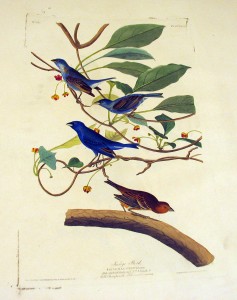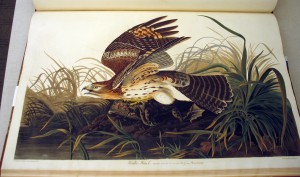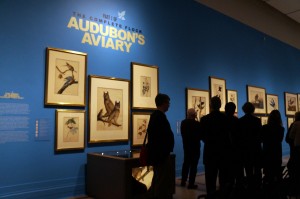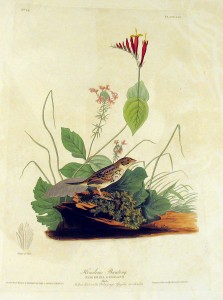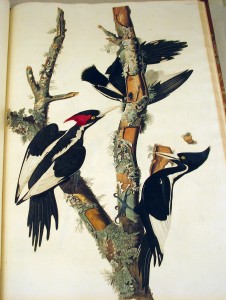 “I have always imagined, that in the plumage of the beautiful Ivory-billed Woodpecker, there is something very closely allied to the style of colouring of the great VANDYKE. The broad extent of its dark glossy body and tail, the large and well-defined white markings of its wings, neck, and bill, relieved by the rich carmine of the pendent crest of the male, and the brilliant yellow of its eye, have never failed to remind me of some of the boldest and noblest productions of that inimitable artist’s pencil. So strongly indeed have these thoughts become ingrafted in my mind, as I gradually obtained a more intimate acquaintance with the Ivory-billed Woodpecker, that whenever I have observed one of these birds flying from one tree to another, I have mentally exclaimed, “There goes a Vandyke!” This notion may seem strange, perhaps ludicrous, to you, good reader, but I relate it as a fact, and whether or not it may be found in accordance with your own ideas, after you have inspected the plate in which is represented this splendid species of the Woodpecker tribe, is perhaps of little consequence.
“I have always imagined, that in the plumage of the beautiful Ivory-billed Woodpecker, there is something very closely allied to the style of colouring of the great VANDYKE. The broad extent of its dark glossy body and tail, the large and well-defined white markings of its wings, neck, and bill, relieved by the rich carmine of the pendent crest of the male, and the brilliant yellow of its eye, have never failed to remind me of some of the boldest and noblest productions of that inimitable artist’s pencil. So strongly indeed have these thoughts become ingrafted in my mind, as I gradually obtained a more intimate acquaintance with the Ivory-billed Woodpecker, that whenever I have observed one of these birds flying from one tree to another, I have mentally exclaimed, “There goes a Vandyke!” This notion may seem strange, perhaps ludicrous, to you, good reader, but I relate it as a fact, and whether or not it may be found in accordance with your own ideas, after you have inspected the plate in which is represented this splendid species of the Woodpecker tribe, is perhaps of little consequence.
… I wish, kind reader, it were in my power to present to your mind’s eye the favourite resort of the Ivory-billed Woodpecker. Would that I could describe the extent of those deep morasses, overshadowed by millions of gigantic dark cypresses, spreading their sturdy moss-covered branches, as if to admonish intruding man to pause and reflect on the many difficulties which he must encounter, should he persist in venturing farther into their almost inaccessible recesses, extending for miles before him, where he should be interrupted by huge projecting branches, here and there the mossy trunk of a fallen and decaying tree, and thousands of creeping and twining plants of numberless species! Would that I could represent to you the dangerous nature of the ground, its oozing, spongy, and miry disposition, although covered with a beautiful but treacherous carpeting, composed of the richest mosses, flags, and water-lilies, no sooner receiving the pressure of the foot than it yields and endangers the very life of the adventurer, whilst here and there, as he approaches an opening, that proves merely a lake of black muddy water, his ear is assailed by the dismal croaking of innumerable frogs, the hissing of serpents, or the bellowing of alligators! Would that I could give you an idea of the sultry pestiferous atmosphere that nearly suffocates the intruder during the meridian heat of our dog days, in those gloomy and horrible swamps! But the attempt to picture these scenes would be vain. Nothing short of ocular demonstration can impress any adequate idea of them.
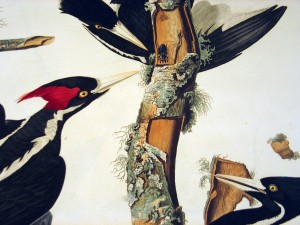 …The Ivory-bill is never seen attacking the corn, or the fruit of the orchards, although it is sometimes observed working upon and chipping off the bark from the belted trees of the newly-cleared plantations. It seldom comes near the ground, but prefers at all times the tops of the tallest trees. Should it, however, discover the half-standing broken shaft of a large dead and rotten tree, it attacks it in such a manner as nearly to demolish it in the course of a few days. I have seen the remains of some of these ancient monarchs of our forests so excavated, and that so singularly, that the tottering fragments of the trunk appeared to be merely supported by the great pile of chips by which its base was surrounded. The strength of this Woodpecker is such, that I have seen it detach pieces of bark seven or eight inches in length at a single blow of its powerful bill, and by beginning at the top branch of a dead tree, tear off the bark, to an extent of twenty or thirty feet, in the course of a few hours, leaping downwards with its body in an upward position, tossing its head to the right and left, or leaning it against the bark to ascertain the precise spot where the grubs were concealed, and immediately after renewing its blows with fresh vigour, all the while sounding its loud notes, as if highly delighted.”
…The Ivory-bill is never seen attacking the corn, or the fruit of the orchards, although it is sometimes observed working upon and chipping off the bark from the belted trees of the newly-cleared plantations. It seldom comes near the ground, but prefers at all times the tops of the tallest trees. Should it, however, discover the half-standing broken shaft of a large dead and rotten tree, it attacks it in such a manner as nearly to demolish it in the course of a few days. I have seen the remains of some of these ancient monarchs of our forests so excavated, and that so singularly, that the tottering fragments of the trunk appeared to be merely supported by the great pile of chips by which its base was surrounded. The strength of this Woodpecker is such, that I have seen it detach pieces of bark seven or eight inches in length at a single blow of its powerful bill, and by beginning at the top branch of a dead tree, tear off the bark, to an extent of twenty or thirty feet, in the course of a few hours, leaping downwards with its body in an upward position, tossing its head to the right and left, or leaning it against the bark to ascertain the precise spot where the grubs were concealed, and immediately after renewing its blows with fresh vigour, all the while sounding its loud notes, as if highly delighted.”
–J. J. Audubon, Ornithological Biography, I (1831), 341-343 [excerpted].
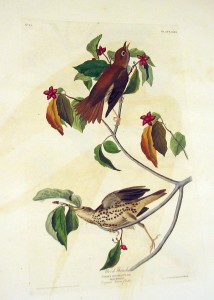 “Kind reader, you now see before you my greatest favourite of the feathered tribes of our woods. To it I owe much. How often has it revived my drooping spirits, when I have listened to its wild notes in the forest, after passing a restless night in my slender shed, so feebly secured against the violence of the storm, as to shew me the futility of my best efforts to rekindle my little fire, whose uncertain and vacillating light had gradually died away under the destructive weight of the dense torrents of rain that seemed to involve the heavens and the earth in one mass of fearful murkiness, save when the red streaks of the flashing thunderbolt burst on the dazzled eye, and, glancing along the huge trunk of the stateliest and noblest tree in my immediate neighbourhood, were instantly followed by an uproar of crackling, crashing, and deafening sounds, rolling their volumes in tumultuous eddies far and near, as if to silence the very breathings of the unformed thought!”
“Kind reader, you now see before you my greatest favourite of the feathered tribes of our woods. To it I owe much. How often has it revived my drooping spirits, when I have listened to its wild notes in the forest, after passing a restless night in my slender shed, so feebly secured against the violence of the storm, as to shew me the futility of my best efforts to rekindle my little fire, whose uncertain and vacillating light had gradually died away under the destructive weight of the dense torrents of rain that seemed to involve the heavens and the earth in one mass of fearful murkiness, save when the red streaks of the flashing thunderbolt burst on the dazzled eye, and, glancing along the huge trunk of the stateliest and noblest tree in my immediate neighbourhood, were instantly followed by an uproar of crackling, crashing, and deafening sounds, rolling their volumes in tumultuous eddies far and near, as if to silence the very breathings of the unformed thought!”